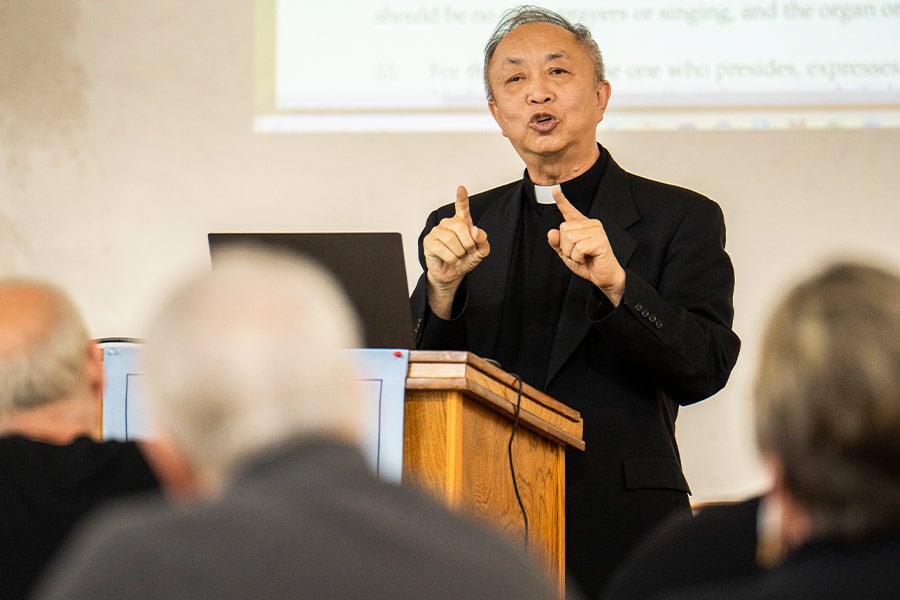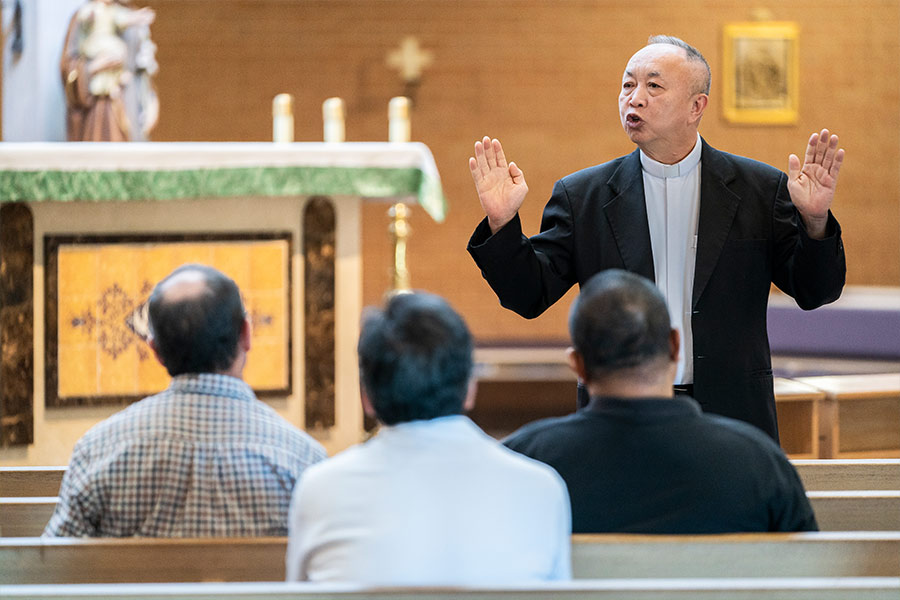Unity and beauty: liturgical workshops emphasize roots and purpose of sacred elements of Mass

Father Thu Nguyen teaches the first liturgical workshop at St. Joseph Church in Arlington in May. (NTC/Juan Guajardo)
ARLINGTON — In more than 10 years serving three different parishes in the Diocese of Fort Worth, Father Thu Nguyen “had a sense” that some parishes did not always conform to the liturgical rubrics in the Roman Missal.
“When I was a pastor, people asked me why our parish does things that other churches don’t do,” Fr. Nguyen recalled.
Then, during the pandemic, he saw those differences with his own eyes. Bishop Michael Olson had named him director of Liturgy and Worship in 2020, which gave him the opportunity to fill in for Masses at different parishes during the COVID-19 outbreak.
Fr. Nguyen, who holds a Master of Liturgy degree, said he “saw a variety of errors in many parishes regarding liturgy.”
“We need to go back to our roots,” he added, “and sometimes we don’t know our roots because we weren’t informed or evangelized to the real essence of it.”
So, Fr. Nguyen is informing and evangelizing those who support parish liturgy with workshops on the dignity and deeper meaning of the rubrics in the Roman Missal. Between May and December, he will present workshops in seven parishes, each consisting of five sessions addressing different liturgical elements. One workshop will be in Vietnamese and another will be in Spanish.
The five sessions cover: a general introduction to liturgy; the sacristy and sacred space ornamentation; altar servers and extraordinary ministers of Holy Communion; sacred music; and sacred Scripture readers and hospitality ministers.
Fr. Nguyen “strongly encourages” parish coordinators and lay ministers to attend all five sessions of the workshop so they will “know the whole picture of liturgy rather than only their specific ministry. They can support each other and understand the flow of the liturgy.”

Father Thu Nguyen, diocesan director of Liturgy and Worship, demonstrates the proper positioning of the hands during a practicum on the Rite of Marriage, on Nov. 13, 2021 at St. Peter the Apostle Church in Fort Worth. (NTC/Juan Guajardo) More photos of the presider training for deacon candidates for Baptisms, weddings, and funerals that Fr. Nguyen conducted can be found in the gallery below.
Leo Wolf, liturgy coordinator for St. Frances Cabrini Parish in Granbury, said, “For five years, I have been praying for this. It’s a godsend.”
Wolf, who has used the Roman Missal for five years, said it’s important to attend the in-person workshop because reading the rubrics isn’t enough.
“We need to participate in discussions to really internalize it and then be able to implement it,” he said. “It’s another step to have your parish grow … and it’s for your own growth.”
At an introductory session May 6 at St. Joseph Parish in Arlington, Fr. Nguyen told lay ministers and deacons they would rediscover the third edition of the General Instruction of the Roman Missal (GIRM), which was implemented in 2013.
“Any appliance comes with a manual. It shows you how it works,” he explained. “The Roman Missal shows us how to celebrate Mass — not just for the priest but also for the people. [The liturgy] needs to conform to what our Church believes, and our Roman Missal dictates that.”
For example, preparing the sanctuary for the liturgical seasons is called “sacred space ornamentation,” not “liturgical environment.” When a priest or liturgy director asks for help decorating the church space, volunteers often come forward who may not have correct or complete instruction on how to adorn the sacred space, Fr. Nguyen explained.
“We don’t add to the sacred space,” he said, “we ornament what is already there — the altar, ambo, presider’s chair, and the tabernacle.”
The GIRM also dictates the number of candles used for different Masses. Daily Mass requires two candles, feast days need four candles, and there should be six candles for solemnities and Sundays.
The number of candles “is not based on your liking,” he said. “It’s based on the Mass.”
Deacon Steve Dixon, who serves St. Stephen Parish in Weatherford, attended the workshop “as a refresher.” He said he appreciated discussions about Pope St. Paul VI’s Sacrosanctum Concilium (Constitution on the Sacred Liturgy), a short document from the Second Vatican Council. He explained that the GIRM outlines the “what” and the “how” of our liturgy, while Sacrosanctum Concilium delves into the “why.”
“A lot more liturgists need to go to that document,” he said. “It gives us the theme that the liturgy should be beautiful … the beauty of the liturgy is found in the small meaningful details that have theology behind them.”
He said the document also “re-emphasizes the sacredness of what we are doing. When we go to Mass we are entering into the heavenly liturgy with the angels and saints. When we say, ‘we join the angels and saints,’ it’s not just beautiful words. It happens… earth and heaven are touching at that time. We’re not just spectators; we are active participants in that liturgy.”
Fr. Nguyen said though parishes can celebrate their individual charisms — how they express themselves — there needs to be unity in the structure of the Mass.
“My whole point is to explain clearly from the Roman Missal how our Church dictates the liturgy,” he said. “My hope is to bring unity to the diocese in the celebration of the Eucharist.”
